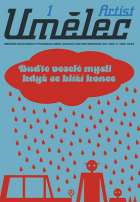| Revista Umělec 1998/1 >> Montreal´s Inflamed Passions | Lista de todas las ediciones | ||||||||||||
|
|||||||||||||
Montreal´s Inflamed PassionsRevista Umělec 1998/101.01.1998 Lucinda Catchlove | montreal | en cs |
|||||||||||||
|
The Montreal Musée d’Art Contemporain’s first show of “young“ local artists in ten years, Of Fire and Passion, has blown a breath of fresh (and hot) air through the museum’s hermetic universe and ignited smoldering controversies in the Montreal art world, high and low. It is not, however, the kind of excited controversy that surrounds shows of young, irreverent, “cutting edge“ artists in London, Paris or New York - in fact, the art itself seems to have become lost in the blazing spectacle debate about the ability of the Museum’s head curator, Réal Lussier, to judge what is actually happening in the contemporary Montreal art scene. Where there’s smoke, there’s fire - and Lussier (whose taste runs to the dry, academic, overly intellectualized aesthetics of the 80‘s) handed local artists and critics the lit match.
Embedded in the ashes of Montreal’s economy is a glowing ember of creativity that makes many young (and older established) artists call Montreal home. As in most financially depressed cities, this has led artists to concoct ingenious, creative ways to make and exhibit their work and freed them (not always willingly) from the constraints of the art market. The result is a wealth of site specific installation, performance and other ephemeral artistic expressions. In fairness, Lussier did find the one flame that fuels current artistic production/climate (at least in the “first“ world), no longer is there any one over-riding aesthetic, theory or practice - diversity rules the day. Hi tech, lo tech, glossy, gnarled, loud, silent, wordy and transcendent - all are represented. The most transcendent being Karilee Fuglem’s Languor. Consisting of three vivid red and pink, oblong, “breathing“ latex “pods“ illuminated from the interior, this is perhaps Fuglem’s most elegant work to date. The slow, silent ‘breathing‘ of the pods combine with the luscious colours like a mantra - the mildly erotic, sensually soothing rhythm lulls the mind and body into a serene state. Few other works approach Languor’s elegant eloquence though many are long winded. Lucie Duval’s Southern Women definitely falls in this category. In a complex, fictional museum housed in an alcove, Duval weaves a narrative of interconnected photographic imagery which takes us from colour photographs of a toy bunny with twisted ears in bondage gear through Nike baseball caps to a curving scimitar. Liberally iced with historical illusions, this confectionery is a tasty mindful. In fact, many of the chosen works reflect Lussier’s taste for the conceptual - or, more accurately, works that read well on paper. Carl Bouchard’s Suicide and Other Assassinations (Connoisseurs Cabinet) consists of 64 heart shaped plastic sacks with straws stuck in their wine stained husks. Mounted on the wall, these dejected specimens encased in insect boxes become metaphors for wasted, consummated, love sucked dry. His other pieces in his Suicide series are less effective - a skull and backbone lying in a baby’s bath tub fails to be more than a pose defined by it’s heavy art historical allusions. Much of the work is uneven in this way, only one of Jacki Danylchuck’s layered, delicately lace cut photographs actually congeals as an expressive whole. Emmanuel Galland’s huge (3 panels of 12 101,6x101,6 cm color photographs of a Superman action figures) Superman exposes questions about both individuality and collectivity in contemporary culture but the unfortunate installation mars its effectiveness. In fact, many of the works suffer from a similar lack of space and the museum environment even seems antithetical to a few. Of Fire and Passion cautiously reflects the same trends surfacing on the international stage, and artists like Fuglem, Carol Dallaire (whose Pathologies secrétes (Les Regards glauques) uses collaged computerized images with text to create a colourful narrative about seduction), Duval, Emmanuelle Léonard (whose beautiful black and white photographs of parking garage interiors are pure abstract sculpture where light and shadow, architecture and stains on the walls combine to create a crisp metaphorical space) and Emmanuel Galland are up to the challenge. Obviously, for many, inclusion in a museum show is a validation - though Lussier, exhibiting as much fire and passion as a wet blanket, made it evident in his essay that he is hesitant to defend the longevity or quality of his choices. While there is much good art in this exhibit there are few brave or even unexpected choices. This could leave one to believe that the creative fires in Montreal are barely hot enough to forge a blunt edge, let alone one that cuts. But perhaps it is the nature of museums to smother and entomb art. Ultimately the sterility of the museum, made it impossible for the young artists to penetrate it’s paradigm. There are enough orgasms in the show to make the wank worth it, but no matter what I do that chafing feeling just won’t go away.
01.01.1998
Artículos recomendados
|
|||||||||||||





Comentarios
Actualmente no hay comentariosAgregar nuevo comentario